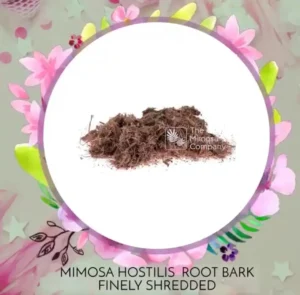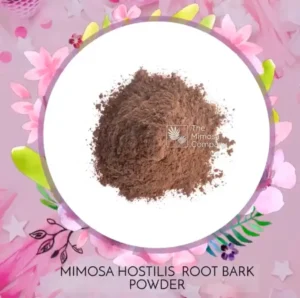At The Mimosa Company, we provide only grade “A” Mimosa Hostilis Root Bark whole, carefully sourced from sustainable wild harvests in Northeast Brazil. With over 6 years of experience, our team works directly with local partners to ensure each batch is pure, ethically harvested, and fully traceable.
What is Mimosa Hostilis Root Bark?
Mimosa Hostilis Root Bark (MHRB) is the reddish-brown inner bark found at the base of the Mimosa tenuiflora tree. This bark is rich in natural tannins, flavonoids, and alkaloids. These compounds give it powerful healing, coloring, and antioxidant properties. We sell them in shredded, chipped, or powdered form, depending on your use.
Key Benefits of Mimosa Hostilis Root Bark
1. Natural Wound Healing Support
For centuries, Indigenous healers have used Mimosa Hostilis Root Bark to treat burns, cuts, and skin infections. It is rich in tannins that help protect the skin while promoting faster healing. Scientific studies have confirmed its antimicrobial and skin-regenerating effects.
2. Vibrant Natural Dye for Fabrics
Mimosa hostilis is highly prized for its use as a natural dye. It produces stunning purple, lavender, and burgundy colors on natural fabrics like cotton, wool, and silk. The dye is long-lasting, non-toxic, and eco-friendly. Its high tannin content also acts as a natural mordant, making it perfect for beginners and professional dyers alike.
3. Skincare and Botanical Formulations
Many natural skincare brands include Mimosa Hostilis in their products due to its ability to soothe inflammation and support skin regeneration. It can be infused into oils, added to soaps, or used in masks and balms.
4. Herbal Research and Ethnobotany
Because of its long traditional use and active plant compounds, Mimosa Hostilis is also of interest in ethnobotanical and phytochemical research.
How to Use Mimosa Hostilis Root Bark
If you are dyeing fabrics, here is a simple guide:
You will need:
- Mimosa Hostilis Root Bark (shredded or powder)
- Natural fiber fabric
- Water
- A stainless steel or enamel dye pot
- Optional mordants like alum or iron
Steps:
- Simmer the bark in water for one to two hours to extract the dye
- Strain the bark and keep the liquid
- Soak your pre-mordanted fabric in the dye bath
- Simmer gently for 45 to 60 minutes
- Rinse with cool water and let dry in the shade
Color Variations by Mordant:
- Alum creates reddish or purple tones
- Iron darkens the fabric to gray-purple
- Copper brings out brown and rustic shades
Ethical and Sustainable Harvesting
We source our Mimosa Hostilis Root Bark from certified wildcrafters who follow strict environmental guidelines. Every harvest helps support local economies and preserves cultural traditions in the region. We never use farmed or overharvested materials, and each batch is quality checked twice for purity and consistency.
We believe in full transparency and responsible business practices. That is why we work closely with Indigenous families and small-scale harvesters who have decades of experience working with this sacred tree.
Why Buy from Us?
- 100 percent natural and authentic Mimosa Hostilis Root Bark
- Ethically sourced from Brazil with full traceability
- No additives, fillers, or preservatives
- Lab-tested for quality and purity
- Fast shipping and excellent customer support
- Trusted by herbalists, artisans, and researchers worldwide





What others are saying
There are no contributions yet.